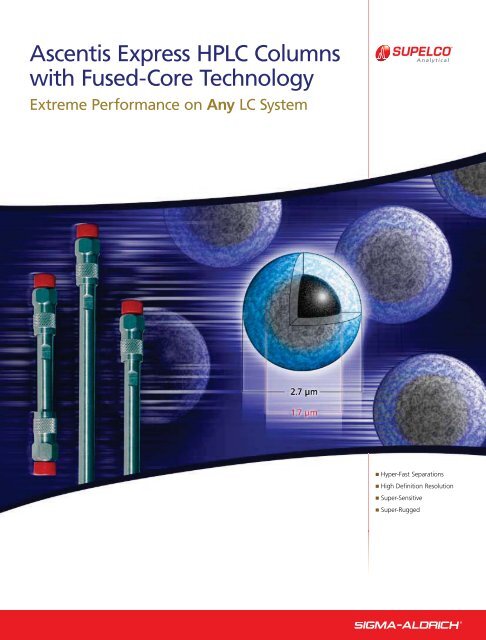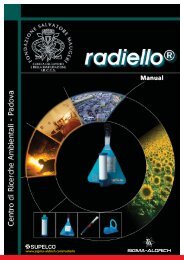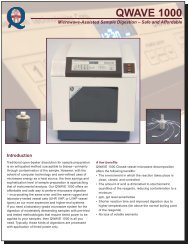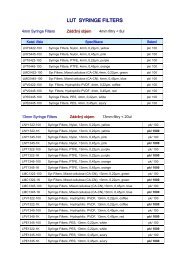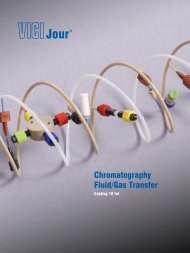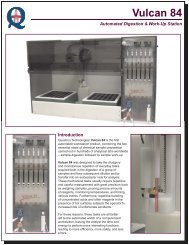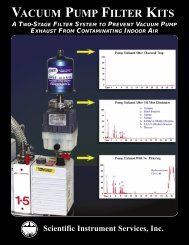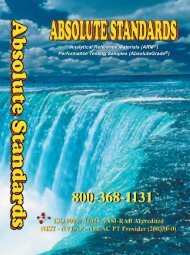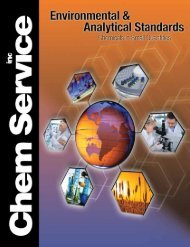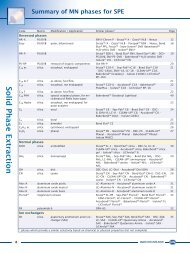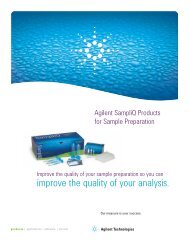Ascentis Express HPLC Columns with Fused-Core Technology ...
Ascentis Express HPLC Columns with Fused-Core Technology ...
Ascentis Express HPLC Columns with Fused-Core Technology ...
You also want an ePaper? Increase the reach of your titles
YUMPU automatically turns print PDFs into web optimized ePapers that Google loves.
<strong>Ascentis</strong> <strong>Express</strong> <strong>HPLC</strong> <strong>Columns</strong><br />
<strong>with</strong> <strong>Fused</strong>-<strong>Core</strong> <strong>Technology</strong><br />
Extreme Performance on Any LC System<br />
Hyper-Fast Separations<br />
High Definition Resolution<br />
Super-Sensitive<br />
Super-Rugged
A Breakthrough in <strong>HPLC</strong> Performance<br />
The <strong>Fused</strong>-<strong>Core</strong> Advantage<br />
<strong>Ascentis</strong> <strong>Express</strong> provides the high speed and high<br />
efficiency of sub-2 μm particles, but at approximately half<br />
the backpressure for the same column length. This lower<br />
pressure means that <strong>Ascentis</strong> <strong>Express</strong> can be run on<br />
conventional <strong>HPLC</strong> and LC-MS systems, as well as<br />
mid-pressure, UPLC and other ultra-high pressure<br />
systems. Lower pressure also means longer columns can<br />
be used for additional resolving power. <strong>Ascentis</strong> <strong>Express</strong><br />
offers these benefits over sub-2 μm particles, along <strong>with</strong><br />
excellent column lifetime.<br />
At the heart of <strong>Ascentis</strong> <strong>Express</strong> is the 2.7 μm <strong>Fused</strong>-<br />
<strong>Core</strong> particle which comprises a 1.7 μm solid core and a<br />
0.5 μm porous shell (Figure 1). Compared to totally<br />
porous particles, the <strong>Fused</strong>-<strong>Core</strong> particles have a much<br />
shorter diffusion path because of the solid core. This<br />
partial porosity reduces axial dispersion of solutes and<br />
minimizes peak broadening. Other features, such as a very<br />
tight particle size distribution and high packing density,<br />
result in <strong>Ascentis</strong> <strong>Express</strong> columns that are capable of<br />
240,000 N/m. This is comparable to the efficiency of<br />
sub-2 μm particle columns and nearly twice the efficiency<br />
possible <strong>with</strong> 3 μm particles.<br />
While the <strong>Ascentis</strong> <strong>Express</strong> efficiency is as high as sub-2<br />
μm columns, the larger particle size delivers approximately<br />
half the backpressure for the same column dimensions and<br />
conditions. This allows <strong>Ascentis</strong> <strong>Express</strong> to turn any <strong>HPLC</strong><br />
system into an extreme performance workhorse for your lab<br />
Figure 1. <strong>Fused</strong>-<strong>Core</strong> Structure of <strong>Ascentis</strong> <strong>Express</strong> Compared to Totally Porous Particles<br />
<strong>Ascentis</strong> <strong>Express</strong> Particle<br />
Totally Porous Particle<br />
1.7 μm<br />
0.5 μm<br />
0.5 μm<br />
Diffusion Path<br />
1.5 μm<br />
2.7 μm<br />
G004388<br />
Table of Contents<br />
<strong>Ascentis</strong> <strong>Express</strong> Topics .................. Page<br />
Speed .......................................................4<br />
Resolution ................................................5<br />
Sensitivity .................................................6<br />
Ruggedness ..............................................7<br />
Alternate Selectivity .............................. 8-9<br />
<strong>Ascentis</strong> <strong>Express</strong> Topics .................. Page<br />
Throughput ....................................... 10-11<br />
Fast <strong>HPLC</strong> .......................................... 12-13<br />
Column Coupling ....................................14<br />
Ordering Information ..............................15<br />
2 sigma-aldrich.com/express ordering: 800-247-6628 (US only) / 814-359-3441
<strong>Ascentis</strong> <strong>Express</strong> FAQs<br />
What is unique about <strong>Ascentis</strong> <strong>Express</strong><br />
<strong>Ascentis</strong> <strong>Express</strong> columns provide a breakthrough in <strong>HPLC</strong><br />
performance. Based on <strong>Fused</strong>-<strong>Core</strong> particle technology, <strong>Ascentis</strong><br />
<strong>Express</strong> provides the benefits of sub-2 μm particles but at much<br />
lower backpressure. These benefits include the capability of<br />
providing fast <strong>HPLC</strong> and higher resolution chromatography. The<br />
<strong>Fused</strong>-<strong>Core</strong> particle consists of a 1.7 μm solid core and a 0.5 μm<br />
porous shell. A major benefit of the <strong>Fused</strong>-<strong>Core</strong> particle is the<br />
small diffusion path (0.5 μm) compared to conventional fully<br />
porous particles. The shorter diffusion path reduces axial<br />
dispersion of solutes and minimizes peak broadening.<br />
Do I need special fittings and tubing<br />
to connect <strong>Ascentis</strong> <strong>Express</strong> columns<br />
While operating pressures may not exceed the 400 bar (6,000<br />
psi) capability of your traditional instruments, sustained pressures<br />
of about 200 bar (3,000 psi) will exceed the recommended<br />
pressure for conventional PEEK tubing and fittings at the column<br />
inlet. We recommend changing to stainless steel fittings in all<br />
high pressure locations and have designed special low-dispersion<br />
connectors (pg. 14) that will stay tight at pressures of 1,000 bar<br />
(15,000 psi) or greater, even when elevated column temperatures<br />
are employed.<br />
What phases are available in <strong>Ascentis</strong> <strong>Express</strong><br />
Currently, C18, C8, RP-Amide, and HILIC (bare silica) phases are<br />
available for <strong>Ascentis</strong> <strong>Express</strong>.<br />
When are additional phases expected<br />
Additional phases are being developed. The best way to track<br />
new products is to visit sigma-aldrich.com/express for the<br />
latest updates.<br />
Can I use <strong>Ascentis</strong> <strong>Express</strong> on any type<br />
of <strong>HPLC</strong> system<br />
<strong>Ascentis</strong> <strong>Express</strong> <strong>HPLC</strong> columns are capable of use on standard<br />
<strong>HPLC</strong> systems as well as U<strong>HPLC</strong> systems. <strong>Columns</strong> are packed in<br />
high pressure hardware capable of <strong>with</strong>standing the pressures<br />
used in U<strong>HPLC</strong> systems.<br />
Is there anything I need to do to my <strong>HPLC</strong><br />
system to use <strong>Ascentis</strong> <strong>Express</strong><br />
Nothing special is required to use <strong>Ascentis</strong> <strong>Express</strong> <strong>HPLC</strong><br />
columns. To obtain the full benefits of <strong>Ascentis</strong> <strong>Express</strong>, one<br />
should minimize dispersion or instrument bandwidth in the<br />
<strong>HPLC</strong> system (tubing, detector flow cell) as well as confirm the<br />
detector response system is set at a fast level. For more<br />
information, request Guidelines for Optimizing Systems for<br />
<strong>Ascentis</strong> <strong>Express</strong> <strong>Columns</strong> (T407102) or visit sigma-aldrich.<br />
com/express and download.<br />
How can I measure my instrument bandwidth<br />
(IBW) and determine what columns can be<br />
used <strong>with</strong> minimal efficiency loss created by<br />
too much internal instrument volume<br />
For simple instructions on how to measure IBW, request Guide<br />
to Dispersion Measurement (T408143) or visit our website<br />
sigma-aldrich.com/express and download.<br />
Can I use <strong>Ascentis</strong> <strong>Express</strong> on a U<strong>HPLC</strong> system<br />
Yes. <strong>Ascentis</strong> <strong>Express</strong> columns are packed in a way making them<br />
suitable for these ultra high pressure instruments. In fact,<br />
<strong>Ascentis</strong> <strong>Express</strong> outperforms sub-2 μm columns on many<br />
applications since <strong>Ascentis</strong> <strong>Express</strong> provides the benefits of sub-2<br />
μm particles but at much lower backpressure.<br />
Can <strong>Ascentis</strong> <strong>Express</strong> columns be used for LC-MS<br />
<strong>Ascentis</strong> <strong>Express</strong> <strong>Fused</strong>-<strong>Core</strong> particles were designed <strong>with</strong> LC-MS<br />
in mind. Even extremely short column lengths exhibit sufficient<br />
plate counts to show high resolving power. The flat van Deemter<br />
plots permit resolution to be maintained at very high flow rates<br />
to maximize sample throughput. All <strong>Ascentis</strong> stationary phases<br />
have been evaluated for MS compatibility during their development,<br />
and the <strong>Express</strong> phases are no exception. A bonus of<br />
<strong>Ascentis</strong> <strong>Express</strong> columns for high throughput U<strong>HPLC</strong> and LC-MS<br />
is that they are extremely rugged and highly resistant to<br />
plugging, a very common failure mode for competitor columns.<br />
What flow rate should I use <strong>with</strong><br />
<strong>Ascentis</strong> <strong>Express</strong> columns<br />
Based on the minimum in the van Deemter curves, higher flows<br />
than 5 μm particle columns are required in order to maximize<br />
<strong>Ascentis</strong> <strong>Express</strong> column efficiency.<br />
<strong>Ascentis</strong> <strong>Express</strong><br />
Suggested Starting Point<br />
<strong>HPLC</strong> Column ID<br />
for Flow Rate<br />
4.6 mm I.D. 1.6 mL/min<br />
3.0 mm I.D. 0.8 mL/min<br />
2.1 mm I.D. 0.4 mL/min<br />
Are guard columns available<br />
Guard columns packed <strong>with</strong> <strong>Ascentis</strong> <strong>Express</strong> are currently not<br />
available. <strong>Ascentis</strong> <strong>Express</strong> columns are rugged and almost all users<br />
prefer operation of <strong>Ascentis</strong> <strong>Express</strong> columns <strong>with</strong>out a guard<br />
column. If you would like to use a guard column, we recommend<br />
the <strong>Ascentis</strong> guard columns.<br />
technical service: 800-359-3041 (US and Canada only) / 814-359-3041<br />
3
Hyper-Fast Separations<br />
Double the Speed<br />
Designed for high flow rates<br />
Half the backpressure of sub-2 μm particles<br />
Compared to sub-2 μm particles, the 2.7 μm <strong>Ascentis</strong><br />
<strong>Express</strong> particles generate approximately half the backpressure.<br />
This permits both longer columns and faster<br />
flow rates.<br />
Figure 2 shows the separation of a steroid mixture on<br />
<strong>Ascentis</strong> <strong>Express</strong> (top) and a conventional sub-2 μm<br />
column (lower) of the same dimensions. Because higher<br />
flow rates on <strong>Ascentis</strong> <strong>Express</strong> – even doubled in this<br />
example – generate similar backpressure, hyper fast<br />
separations are possible that have efficiency and resolution<br />
equal to the sub-2 μm particle column.<br />
Shown in Figure 3 is a comparison against a traditional<br />
15 cm, 5 μm column and a 5 cm, <strong>Ascentis</strong> <strong>Express</strong>. The<br />
chromatograms further illustrate the high-speed<br />
capabilities of <strong>Ascentis</strong> <strong>Express</strong> at backpressures manageable<br />
by all <strong>HPLC</strong> systems. High flow rates are quite<br />
amenable to <strong>Ascentis</strong> <strong>Express</strong> <strong>HPLC</strong> columns due to the<br />
<strong>Fused</strong>-<strong>Core</strong> particle.<br />
Figure 2. Hyper-Fast Separations on <strong>Ascentis</strong> <strong>Express</strong>:<br />
Twice the Speed at Equivalent Pressure<br />
columns: <strong>Ascentis</strong> <strong>Express</strong> C18, 10 cm x 2.1 mm I.D., 2.7 μm particles<br />
(53823-U) and sub-2 μm particle column (same dimensions)<br />
mobile phase: 49:51 or 55:45, water:acetontrile<br />
flow rate: 0.4 or 0.2 mL/min.<br />
temp.: ambient<br />
det.: UV at 200 nm<br />
injection: 1 μL<br />
1. Estradiol<br />
<strong>Ascentis</strong> <strong>Express</strong> C18<br />
0.4 mL/min flow rate<br />
1<br />
2<br />
3<br />
C18 Sub-2 μm<br />
0.2 mL/min flow rate<br />
1<br />
4<br />
5<br />
G003975<br />
2<br />
3000 psi<br />
3000 psi<br />
2. -Estradiol<br />
3. Impurity<br />
4. Estrone<br />
5. Estrone degradant<br />
TWICE<br />
THE SPEED<br />
AT EQUAL<br />
PRESSURES<br />
4<br />
Figure 3. Hyper-Fast Separations on <strong>Ascentis</strong> <strong>Express</strong>:<br />
Eight Times the Speed of Traditional <strong>Columns</strong><br />
column: <strong>Ascentis</strong> <strong>Express</strong> C18, 5 cm x 3.0 mm I.D. and<br />
5 μm particle column, 15 cm x 3.0 mm I.D.<br />
mobile phase: 31:69, water:acetonitrile<br />
flow rate: 1.2 mL/min or 0.4 mL/min<br />
temp.: 35° C<br />
inj.: 0.5 μL<br />
<strong>Ascentis</strong> <strong>Express</strong> C18<br />
1.2 mL/min flow rate<br />
mV<br />
0 20 40<br />
EIGHT<br />
TIMES<br />
FASTER<br />
1<br />
2<br />
3<br />
2<br />
1. Uracil<br />
2. Phenol<br />
3. Acetophenone<br />
4. Benzene<br />
5. Toluene<br />
6. Naphthalene<br />
0 10<br />
Sec<br />
20 30<br />
G004158<br />
C18 5 μm<br />
0.4 mL/min flow rate<br />
4<br />
5<br />
6<br />
6<br />
3<br />
5<br />
G003976<br />
mAU<br />
0 20 40<br />
1<br />
3<br />
4<br />
5<br />
0.0 1.0 2.0 3.0 4.0<br />
Min<br />
G004157<br />
4 sigma-aldrich.com/express ordering: 800-247-6628 (US only) / 814-359-3441
High Definition “HD”-Resolution<br />
Double the Efficiency<br />
Short analyte diffusion path<br />
Twice the efficiency of 3 μm particles<br />
Longer columns permit doubling the plates over<br />
sub-2 μm particles<br />
Compared to conventional 3 μm and 5 μm particles,<br />
<strong>Ascentis</strong> <strong>Express</strong> <strong>HPLC</strong> columns provide sharper peaks<br />
under the same conditions. By simply swapping in an<br />
<strong>Ascentis</strong> <strong>Express</strong> <strong>HPLC</strong> column of the equivalent dimensions<br />
to your current 3 μm and 5 μm particle <strong>HPLC</strong> columns, an<br />
improvement in resolution can be achieved. This improvement<br />
is shown in Figure 4. Note: Remember <strong>Ascentis</strong><br />
<strong>Express</strong> <strong>HPLC</strong> column recommended flow rates are higher<br />
than that for conventional 3 μm and 5 μm particles.<br />
<strong>Ascentis</strong> <strong>Express</strong> and sub-2 μm columns of the same<br />
dimensions give approximately the same number of<br />
Figure 4. HD-Resolution on <strong>Ascentis</strong> <strong>Express</strong>: Sharper<br />
Peaks than Traditional <strong>Columns</strong><br />
<strong>Ascentis</strong> <strong>Express</strong><br />
5 μm<br />
theoretical plates (efficiency). However, because<br />
<strong>Ascentis</strong> <strong>Express</strong> columns are more permeable and<br />
exhibit half the backpressure, you can use longer<br />
columns for even more resolving power. The high<br />
backpressure generated by the sub-2 μm particles<br />
precludes the use of longer columns, even on ultra-high<br />
pressure systems under ambient conditions.<br />
An example of the HD-Resolution is shown in Figure 5<br />
where the additional theoretical plates on the 10 cm<br />
<strong>Ascentis</strong> <strong>Express</strong> column provided significantly better<br />
resolution of -estradiol and the impurity compared to<br />
the 5 cm sub-2 μm column at comparable backpressures.<br />
Figure 5. HD-Resolution on <strong>Ascentis</strong> <strong>Express</strong> Compared<br />
to Sub-2 μm <strong>Columns</strong><br />
columns: <strong>Ascentis</strong> <strong>Express</strong> C18, 10 cm x 2.1 mm I.D., 2.7 μm particles<br />
(53823-U) and sub-2 μm particle column, 5 cm x 2.1 mm I.D.<br />
mobile phase: 55:45 or 54:46, water:acetontrile<br />
flow rate: 0.2 mL/min.<br />
1400 psi<br />
temp.: ambient<br />
det.: UV at 200 nm<br />
injection: 1 μL<br />
<strong>Ascentis</strong> <strong>Express</strong> C18<br />
10 cm length<br />
1<br />
2<br />
4<br />
1. Estradiol<br />
2. -Estradiol<br />
3. Impurity<br />
4. Estrone<br />
5. Estrone degradant<br />
TWICE THE<br />
RESOLUTION<br />
AT EQUAL<br />
PRESSURE<br />
3<br />
5<br />
G003973<br />
SHARPER<br />
PEAKS THAN<br />
REGULAR<br />
COLUMNS<br />
C18 Sub-2 μm<br />
5 cm length<br />
1<br />
1650 psi<br />
2<br />
4<br />
3<br />
5<br />
G003974<br />
G004328<br />
technical service: 800-359-3041 (US and Canada only) / 814-359-3041<br />
5
Super-Sensitive<br />
High Sample Loading Capacity and Signal/Noise<br />
for Trace Analysis<br />
High column efficiency for high S/N<br />
High sample loading from thick, porous shell layer<br />
Trace analysis benefits from high column efficiency.<br />
Efficient peaks are taller and provide higher S/N ratios. As<br />
discussed in earlier sections of this brochure, the <strong>Ascentis</strong><br />
<strong>Express</strong> columns can provide higher efficiency than any<br />
traditional particle. The added sensitivity of the higher<br />
efficiency <strong>Ascentis</strong> <strong>Express</strong> particles is visualized as the<br />
“sensitivity gap” in Figure 6.<br />
Figure 6. Higher Efficiency of <strong>Ascentis</strong> <strong>Express</strong> Provides<br />
Better Sensitivity than Traditional <strong>Columns</strong><br />
columns: as indicated; 10 cm x 4.6 mm I.D.<br />
mobile phase : acetonitrile:water<br />
flow rate: 1.8 mL/min<br />
temp.: 35° C<br />
det.: 254 nm<br />
injection: 5 μL<br />
1. Uracil<br />
2. Acetophenone<br />
3. Benzene<br />
4. Toluene<br />
<strong>Ascentis</strong> <strong>Express</strong><br />
Traditional 3 μm<br />
Traditional 5 μm<br />
BETTER<br />
SENSITIVITY<br />
THAN REGULAR<br />
COLUMNS<br />
Sensitivity Gap<br />
Sensitivity<br />
Gap<br />
Figure 7. Higher Loading Capacity of <strong>Ascentis</strong> <strong>Express</strong><br />
Compared to Sub-2 μm Particles<br />
Peak Symmetry as a Measure of Overload<br />
1.50<br />
1.30<br />
1.10<br />
0.90<br />
0.70<br />
Sub-2 μm<br />
Quickly<br />
Overloads<br />
<strong>Ascentis</strong> <strong>Express</strong> C18<br />
HAS HIGH LOADING CAPACITY<br />
0.50<br />
0.00 5.00 10.00 15.00 20.00 25.00<br />
Concentration (μL/mL)<br />
Figure 8 shows how <strong>Ascentis</strong> <strong>Express</strong> extends the<br />
dynamic range. It has the high efficiency of sub-2 μm<br />
particles needed for trace analysis, and the high surface<br />
area of totally porous particles needed for high sample<br />
capacity.<br />
Figure 8. Extended Dynamic Range of <strong>Ascentis</strong> <strong>Express</strong><br />
HIGH<br />
G004330<br />
Although they have a solid core, the 0.5 μm-thick<br />
“shell” of the <strong>Fused</strong>-<strong>Core</strong> particles provides roughly 75%<br />
of the surface area as a totally porous particle of the same<br />
diameter. Only the pores <strong>with</strong> very long diffusion paths<br />
are fused in the <strong>Ascentis</strong> <strong>Express</strong> <strong>HPLC</strong> columns. The<br />
resulting particles have effective surface areas of ~225<br />
m²/g; comparable to totally porous particles. The higher<br />
surface area gives higher sample loading capacity<br />
compared to sub-2 μm particles, as evidenced by the<br />
symmetry vs. concentration relationship in Figure 7. Above<br />
5 ppm, the sub-2 μm experiences sample overload and<br />
subsequent loss of peak shape.<br />
Dynamic Range<br />
(Analyte Concentration)<br />
LOW<br />
Sub-2 μm<br />
Particles<br />
3 μm<br />
Particles<br />
<strong>Ascentis</strong> <strong>Express</strong><br />
Particles Have High<br />
Surface Area and High<br />
Efficiency for Wide<br />
Dynamic Range<br />
6 sigma-aldrich.com/express ordering: 800-247-6628 (US only) / 814-359-3441
Super-Rugged <strong>Columns</strong><br />
Extended Column Lifetime Compared to Both 3 μm and<br />
sub-2 μm <strong>Columns</strong><br />
Narrow particle size distribution allows<br />
use of 2 μm frits<br />
Dense particles for more stable bed<br />
Figure 9. Narrow Particle Size Distribution of<br />
<strong>Ascentis</strong> <strong>Express</strong><br />
<strong>Fused</strong>-<strong>Core</strong> particles are produced in a way that yields<br />
an extremely narrow particle size distribution (Figure 9).<br />
This narrow particle size distribution permits the use of<br />
frits <strong>with</strong> nominal 2 μm pores, the same as used on most<br />
columns packed <strong>with</strong> 5 μm particles. In comparison,<br />
sub-2 μm particles require frits <strong>with</strong> much smaller pore<br />
size – 0.5 μm or smaller – that are prone to fouling, lead<br />
to peak-splitting and high backpressure, and ultimately<br />
shorten the column lifetime. Another feature of the<br />
<strong>Fused</strong>-<strong>Core</strong> particles that contributes to their ruggedness<br />
is that they are denser than totally porous particles and<br />
form highly stable beds in the packed column.<br />
<strong>Ascentis</strong> <strong>Express</strong><br />
NARROW PARTICLE<br />
SIZE DISTRIBUTION<br />
Absence of<br />
Fine Particles<br />
in <strong>Ascentis</strong> <strong>Express</strong><br />
Allows Larger<br />
Pore Size Frits<br />
Porous Particle -<br />
Broad Particle Size<br />
Distribution<br />
Sample Prep Simplicity<br />
Combines the simplicity of protein<br />
precipitation and the selectivity<br />
of SPE for the targeted removal<br />
of phospholipids and proteins<br />
from biological samples<br />
NEW! HybridSPE – Precipitation <strong>Technology</strong><br />
Reduce ion-suppression<br />
100% removal of phospholipids & precipitated proteins<br />
Minimal to no method development<br />
Available in 96-well and 1 mL cartridge dimensions<br />
To learn more, visit our website: sigma-aldrich.com/hybridspe-ppt or contact Supelco Technical Service at<br />
800-359-3041/814-359-3041 and techservice@sial.com<br />
technical service: 800-359-3041 (US and Canada only) / 814-359-3041<br />
7
Alternative Selectivity <strong>with</strong><br />
<strong>Ascentis</strong> <strong>Express</strong> RP-Amide<br />
<strong>Ascentis</strong> <strong>Express</strong> RP-Amide can solve<br />
Co-eluting peaks<br />
Unresolved components<br />
Poor retention of polar compounds<br />
Peak tailing of basic compounds<br />
Silanol interactions causing poor reproducibility<br />
While the <strong>Ascentis</strong> <strong>Express</strong> C18 provides classic<br />
reversed-phase selectivity, the <strong>Ascentis</strong> <strong>Express</strong> RP-Amide<br />
provides increased selectivity for polar compounds,<br />
especially those that can act as a hydrogen-bond donor.<br />
Other attributes of the RP-Amide include improved peak<br />
shape for bases, 100% aqueous compatibility, and low<br />
bleed for LC-MS applications.<br />
The amide group provides enhanced selectivity <strong>with</strong><br />
analytes that have hydrogen bonded to a heteroatom.<br />
Phenols, carboxylic acids, amines and, to a lesser extent,<br />
alcohols show enhanced retention on the RP-Amide phase<br />
when compared to neutral non-polar analytes. An<br />
example of the power of the hydrogen bonding mechanism<br />
is shown in Figure 10. The <strong>Ascentis</strong> <strong>Express</strong> C18 and<br />
RP-Amide columns are compared. The analyte mixture<br />
contains neutral, non-polar analytes (benzene and<br />
toluene) and protic analytes (p-methoxyphenol, p-nitrobenzoic<br />
acid, and p-chlorophenol). As observed from<br />
the chromatograms in Figure 1, the neutral molecules<br />
show slightly reduced retention on the RP-Amide, but the<br />
protic molecules show greatly enhanced retention yielding<br />
a chromatogram <strong>with</strong> very different selectivities and even<br />
a change in elution order. The potential for solving<br />
separations difficulties is tremendous.<br />
Two other points should be noted. The <strong>Ascentis</strong> <strong>Express</strong><br />
RP-Amide has the same high efficiency as the <strong>Ascentis</strong><br />
<strong>Express</strong> C18 <strong>with</strong> the same low back-pressure. Secondly,<br />
both separations were carried out in the same mobile<br />
phase. This is important since it simplifies method<br />
development. If a separation is not adequate on an<br />
<strong>Express</strong> C18, there is no need to change mobile phase to<br />
optimize the separation, simply switch to the <strong>Ascentis</strong><br />
<strong>Express</strong> RP Amide and if protic moieties are present, a<br />
change in selectivity will be achieved.<br />
Figure 10. Alternative Selectivity Provided by <strong>Ascentis</strong><br />
<strong>Express</strong> RP-Amide Compared to C18<br />
columns: <strong>Ascentis</strong> <strong>Express</strong> RP-Amide, 10 cm x 4.6 mm I.D.<br />
<strong>Ascentis</strong> <strong>Express</strong> C18, 10 cm x 4.6 mm I.D.<br />
mobile phase: 40:60, 0.1% formic acid in water:methanol<br />
flow rate: 1.0 mL/min<br />
temp.: 25° C<br />
det.: 254 nm<br />
injection: 5 μL<br />
1<br />
1. Uracil<br />
2. p-Methoxyphenol<br />
3. Acetophenone<br />
4. p-Nitrobenzoic acid<br />
5. p-Chlorophenol<br />
6. Benzene<br />
7. Toluene<br />
2<br />
3<br />
4<br />
6 5<br />
0 2 4<br />
6<br />
Min<br />
1<br />
2<br />
3<br />
4<br />
<strong>Ascentis</strong> <strong>Express</strong> RP-Amide<br />
<strong>Ascentis</strong> <strong>Express</strong> C18<br />
5<br />
0 2 4<br />
6<br />
Min<br />
6<br />
7<br />
G004315<br />
7<br />
G004316<br />
<strong>Ascentis</strong> <strong>Express</strong> RP-Amide Applications<br />
Natural products<br />
Phenolics<br />
Bases<br />
Metabolites<br />
Polar Compounds<br />
8 sigma-aldrich.com/express ordering: 800-247-6628 (US only) / 814-359-3441
Polar Compound Retention <strong>with</strong><br />
<strong>Ascentis</strong> <strong>Express</strong> HILIC<br />
Benefits of HILIC Separation<br />
Retention of highly polar analytes like metabolites<br />
Complimentary selectivity to reversed-phase<br />
chromatography<br />
Increased MS sensitivity<br />
Quick transfer from final steps of sample prep<br />
(SPE, protein precipitation, etc.)<br />
HILIC chromatography is gaining popularity due to<br />
increased retention of polar compounds. Many classes of<br />
polar compounds can be retained in HILIC. These include<br />
polar neutrals, polar acids, and polar and non-polar basic<br />
amines. Both polar and ionic interactions can contribute to<br />
retention and selectivity in this mode of chromatography.<br />
Figure 11. Comparison of the Analysis of Polar Molecules<br />
on <strong>Ascentis</strong> <strong>Express</strong> HILIC and <strong>Ascentis</strong> <strong>Express</strong> C18<br />
columns: <strong>Ascentis</strong> <strong>Express</strong> HILIC, 10 cm x 2.1 mm ID,<br />
2.7 μm particles (53939-U)<br />
<strong>Ascentis</strong> <strong>Express</strong> C18, 10 cm x 2.1 mm ID,<br />
2.7 μm particles (53823-U)<br />
mobile phase: 10:90; 100 mM ammonium formate, pH 3.0 <strong>with</strong><br />
concentrated formic acid:acetonitrile<br />
flow rate: 0.4 mL/min<br />
temp.: 35 °C<br />
det.: UV at 254 nm<br />
injection: 1 μL<br />
1. Acenaphthene, 80 μg/mL in mobile phase<br />
2. Adenosine, 35 μg/mL in mobile phase<br />
3. Cytosine, 75 μg/mL in mobile phase<br />
Acenaphthene<br />
How HILIC works<br />
HILIC separates compounds by using a mostly organic<br />
mobile phase across a polar stationary phase, causing<br />
solutes to elute in order of increasing polarity-the opposite<br />
of Reversed-Phase. Retention in HILIC is likely to be a<br />
combination of hydrophilic interaction, ion-exchange, and<br />
some reversed-phase retention. A typical mobile phase<br />
consists of 60-95% acetonitrile and an aqueous buffer.<br />
10-20 mM ammonium acetate or ammonium formate are<br />
useful due to volatility and solubility. The sample solvent<br />
should be similar in type and strength as the mobile phase.<br />
The sample solvent can contain a higher amount of organic<br />
than the mobile phase, but should not contain more water<br />
than the mobile phase.<br />
<strong>Ascentis</strong> <strong>Express</strong> HILIC<br />
2<br />
1<br />
3<br />
<strong>Ascentis</strong> <strong>Express</strong> C18<br />
2,3<br />
Adenosine<br />
G004182<br />
G003620<br />
G004183<br />
Shown in Figure 11 is a comparison of the analysis of<br />
highly polar molecules on <strong>Ascentis</strong> <strong>Express</strong> HILIC and<br />
<strong>Ascentis</strong> <strong>Express</strong> C18.<br />
Cytosine<br />
<strong>Ascentis</strong> <strong>Express</strong> HILIC Applications<br />
Amino acids<br />
Small, polar acids – (metabolomics)<br />
Biogenic amines – (neurotransmitters,<br />
contaminants in food &<br />
beverage)<br />
Phosphates – (pesticides, herbicides)<br />
Sugars<br />
Drug metabolites and conjugates<br />
G003033<br />
1<br />
0 1<br />
2 3 4<br />
5<br />
Min<br />
G004184<br />
technical service: 800-359-3041 (US and Canada only) / 814-359-3041<br />
9
Improving <strong>HPLC</strong> Sample Throughput<br />
Do More Work in Less Time Without Changing<br />
Your Method<br />
The demand for increased sample throughput and speed<br />
of results has driven <strong>HPLC</strong> users to search for breakthroughs<br />
in <strong>HPLC</strong> instruments and column technology.<br />
Although improvements have been realized, setbacks have<br />
been encountered. Reduction in column ruggedness, costly<br />
replacements of existing instrumentation, and difficulties in<br />
transferring methods to new systems have often made<br />
these past improvements unappealing to analysts.<br />
The <strong>Fused</strong>-<strong>Core</strong> <strong>HPLC</strong> particle technology behind<br />
<strong>Ascentis</strong> <strong>Express</strong> permits 4- to 6-fold reduction in analysis<br />
time, <strong>with</strong> a subsequent increase in sample throughput<br />
compared to conventional <strong>HPLC</strong> columns, <strong>with</strong>out<br />
sacrificing resolution or column ruggedness and <strong>with</strong>out<br />
the need to change systems or sample prep procedures<br />
The current high resolution column for traditional <strong>HPLC</strong><br />
methods is a 25 cm column packed <strong>with</strong> 5 μm particles.<br />
Until now, this dimension provided the most efficiency<br />
<strong>with</strong>in the pressure limit of a conventional <strong>HPLC</strong> system.<br />
With the high efficiency <strong>Ascentis</strong> <strong>Express</strong>, one can now<br />
achieve the same number of plates as a 25 cm column<br />
packed <strong>with</strong> 5 μm particles <strong>with</strong> a 10 cm column or even<br />
more efficiency and resolution <strong>with</strong> a 15 cm <strong>Ascentis</strong><br />
<strong>Express</strong> column. Therefore, by simply changing columns<br />
and keeping all other conditions the same, you can reduce<br />
the runtime and increase the resolution of your method.<br />
Figure 12 compares the resolution of a five-component<br />
sample on 25 cm, 5 μm C18 and 10 cm <strong>Ascentis</strong> <strong>Express</strong><br />
C18 columns. Each column has approximately the same<br />
number of theoretical plates and hence the same resolving<br />
power. However the shorter <strong>Ascentis</strong> <strong>Express</strong> column<br />
delivers this separation in a much shorter time, in this case<br />
less than one-fourth the time as the 25 cm column.<br />
Figure 12. Increase Sample Throughput by Using <strong>Ascentis</strong> <strong>Express</strong><br />
C18, 25 cm x 4.6 mm I.D., 5 μm particles<br />
mobile phase: 65:35, water:acetonitrile<br />
flow rate: 1 mL/min<br />
temp.: ambient<br />
det.: UV at 254 nm<br />
1. Oxazepam: FW = 286<br />
2. Alprazolam: FW = 311<br />
3. Cloazepam: FW = 315<br />
4. N-desmethyldiazepam: FW = 270<br />
5. Diazepam: FW = 284<br />
1X<br />
41.5 Min.<br />
0 10 20 30 40 Min<br />
G004039<br />
<strong>Ascentis</strong> <strong>Express</strong> C18, 10 cm x 4.6 mm I.D., 2.7 μm particles (53827-U)<br />
1X<br />
9.5 Min.<br />
2X<br />
19 Min.<br />
3X<br />
28.5 Min.<br />
4X<br />
38 Min.<br />
0 10 0 10 0 10 0 10<br />
G004040<br />
Ready to do more work in less time<br />
See the flow chart on the next page.<br />
<br />
10 sigma-aldrich.com/express ordering: 800-247-6628 (US only) / 814-359-3441
Selecting the Optimal <strong>Ascentis</strong> <strong>Express</strong> Column<br />
Is<br />
your<br />
column a<br />
25 cm (5 μm),<br />
15 cm (5 μm), or<br />
10 cm (3 μm)<br />
YES<br />
Do<br />
you want to<br />
MAXIMIZE SPEED<br />
or IMPROVE<br />
RESOLUTION &<br />
SPEED<br />
NO<br />
Convert to <strong>Ascentis</strong> <strong>Express</strong><br />
<strong>HPLC</strong> <strong>Columns</strong> for Both!<br />
Email Supelco<br />
Technical Service<br />
to assist in<br />
selecting an<br />
optimal<br />
<strong>Ascentis</strong> <strong>Express</strong><br />
Column<br />
techservice@sial.com<br />
MAXIMIZE<br />
SPEED<br />
1A.1: Conversion Table<br />
Current <strong>Ascentis</strong><br />
Column <strong>Express</strong><br />
25 cm (5 μm) 10 cm<br />
15 cm (5 μm) 7.5 cm<br />
10 cm (3 μm) 5 cm<br />
IMPROVE RESOLUTION<br />
& SPEED<br />
1B.1: Conversion Table<br />
Current <strong>Ascentis</strong><br />
Column <strong>Express</strong><br />
25 cm (5 μm) 15 cm<br />
15 cm (5 μm) 10 cm<br />
10 cm (3 μm) 7.5 cm<br />
2: Maximize flow rate <strong>with</strong>in system pressure constraints *<br />
<strong>Ascentis</strong> <strong>Express</strong><br />
Suggested Starting Point<br />
<strong>HPLC</strong> Column ID<br />
for Flow Rate<br />
4.6 mm I.D. 1.6 mL/min<br />
3.0 mm I.D. 0.8 mL/min<br />
2.1 mm I.D. 0.4 mL/min<br />
3: Confirm method suitability parameters<br />
3.1:<br />
Is resolution<br />
maintained<br />
NO<br />
YES<br />
3.3:<br />
Is additional<br />
throughput or<br />
resolution<br />
desired<br />
YES<br />
NO<br />
Improved sample<br />
throughput <strong>with</strong><br />
<strong>Ascentis</strong> <strong>Express</strong><br />
and your existing<br />
<strong>HPLC</strong> system<br />
3.2:<br />
Select longer<br />
column<br />
3.2:<br />
Select shorter column<br />
or faster flow rate<br />
*Read Guidelines for Optimizing Systems for <strong>Ascentis</strong> <strong>Express</strong> <strong>Columns</strong> (T407102) and Guide to Dispersion Measurement (T408143).<br />
technical service: 800-359-3041 (US and Canada only) / 814-359-3041<br />
11
Fast <strong>HPLC</strong> for Rapid Screening of<br />
Pharmaceutical Compounds<br />
Ideal for Walk-up LC-MS Systems<br />
<strong>HPLC</strong> is critical to the discovery, development and<br />
eventual commercialization of pharmaceutical products.<br />
<strong>HPLC</strong> is the benchmark analytical method in the pharmaceutical<br />
industry due to its ability to score such high marks<br />
in analytical validation characteristics including accuracy,<br />
precision, limit of detection, specificity, linearity and<br />
range, and ruggedness. No other analytical techniques<br />
can consistently score high in all characteristics on<br />
compounds and matrices that are of interest to the<br />
pharmaceutical industry.<br />
Furthermore, it has been generally accepted that a<br />
typical <strong>HPLC</strong> analysis takes 15-30 minutes <strong>with</strong> some as<br />
great as an hour. When multiplied by the number of<br />
samples to be analyzed either in discovery or product<br />
release, the total instrument time required is staggering.<br />
This overwhelming amount of instrument time has<br />
resulted in a growing number of instruments, around-theclock<br />
analysis, and a push for faster methods.<br />
Fast <strong>HPLC</strong>, using short columns (3-10 cm) packed <strong>with</strong><br />
small particles (
Shown in Figure 13 is the separation of six tricyclic<br />
antidepressants (TCAs). The separation of these closely<br />
related compounds was performed under isocratic mobile<br />
phase conditions <strong>with</strong> mass spectrometric (MS) detection.<br />
Baseline resolution was achieved <strong>with</strong> a total separation<br />
time of 3 minutes demonstrating not only the potential<br />
speed of the <strong>Ascentis</strong> <strong>Express</strong> columns but also the<br />
resolving power. Note the MS compatible mobile phase<br />
and flow rate. Furthermore, the use of 2.1 mm I.D. columns<br />
provides a reduction in solvent consumption compared to<br />
typical flow rates for 4.6 mm I.D. or monolithic columns.<br />
Data in Figure 14 further illustrates the speed in which<br />
closely related compounds can be resolved using the<br />
<strong>Fused</strong>-<strong>Core</strong> particle. In this example, four -blockers are<br />
resolved in less than one minute under isocratic conditions<br />
utilizing MS detection. While a 10 cm column was utilized<br />
for the TCAs separation, a 5 cm column was used for the<br />
-blockers example.<br />
The separation of three steroids as well as a related<br />
impurity and degradant is shown in Figure 15. A high<br />
mobile phase flow rate of 0.6 mL/min was utilized and is<br />
suitable for <strong>Ascentis</strong> <strong>Express</strong> columns due to the Van<br />
Deemter curve associated <strong>with</strong> these columns. Isocratic<br />
mobile phase conditions were utilized as well as UV<br />
detection at 200 nm, a common detection wavelength<br />
for impurity profiling. Again, baseline resolution was<br />
achieved for all compounds <strong>with</strong> a total runtime of less<br />
than two minutes. It should be noted that the isocratic<br />
conditions used in these examples further enhances<br />
sample throughput versus gradient conditions due to no<br />
need for column re-equilibration. With a backpressure of<br />
just 4500 psi, this analysis could be performed on almost<br />
any <strong>HPLC</strong> system. A similar separation was attempted<br />
using a sub-2 μm particle column but was not possible<br />
given the same instrument constraints put on the<br />
<strong>Ascentis</strong> <strong>Express</strong> column.<br />
Figure 14. -Blockers on <strong>Ascentis</strong> <strong>Express</strong><br />
column: <strong>Ascentis</strong> <strong>Express</strong> C18, 5 cm x 2.1 mm ID (53822-U)<br />
instrument: Agilent 1100<br />
mobile phase A: 0.1% acetic acid in water<br />
mobile phase B: 0.1% acetic acid in acetonitrile<br />
mobile phase ratios: A:B = 74:26<br />
flow rate: 0.2 mL/min<br />
temp.: 35 °C<br />
det.: ABI 3200 QT; ESI(+), MS/MS<br />
injection: 1 μL<br />
1. Atenolol<br />
2. Pindolol<br />
3. Timolol<br />
4. Metoprolol<br />
Figure 15. Steroids on <strong>Ascentis</strong> <strong>Express</strong><br />
column: <strong>Ascentis</strong> <strong>Express</strong> C18, 10 cm x 2.1 mm ID (53823-U)<br />
instrument: Jasco X-LC<br />
mobile phase: 55:45 water:acetonitrile<br />
flow rate: 0.6 mL/min<br />
temp.: ambient<br />
det.: 200 nm<br />
injection: 1 μL<br />
1. Estriol<br />
2. -Estradiol<br />
3. Impurity<br />
4. Estrone<br />
5. Estrone degradant<br />
2<br />
1<br />
2<br />
4<br />
3<br />
1<br />
4<br />
3<br />
5<br />
G004063<br />
G004064<br />
technical service: 800-359-3041 (US and Canada only) / 814-359-3041<br />
13
Ultra-High Resolution <strong>HPLC</strong>:<br />
Column Coupling<br />
Maximize the Resolution of U<strong>HPLC</strong> systems<br />
Column coupling in <strong>HPLC</strong> is gaining interest since LC<br />
systems are being designed to <strong>with</strong>stand column back<br />
pressures of up to 15,000 psi. Column coupling is a simple<br />
and practical way to increase resolution by simply<br />
increasing column length. Because <strong>Ascentis</strong> <strong>Express</strong> <strong>HPLC</strong><br />
columns provide higher efficiencies at any pressure<br />
compared to 3 μm and sub-2 μm particles, the coupling<br />
of <strong>Ascentis</strong> <strong>Express</strong> columns enables significantly higher<br />
resolution than any other column on any commercial<br />
<strong>HPLC</strong> system.<br />
Efficiencies greater than 150,000 plates/column are<br />
possible and demonstrated in the isocratic separation of<br />
benzene and toluene <strong>with</strong> various deuterium substitutions.<br />
Figure 16 shows the efficiency obtained by coupling 5<br />
<strong>Ascentis</strong> <strong>Express</strong> 15 cm columns together.<br />
Figure 16. Column Coupling of <strong>Ascentis</strong> <strong>Express</strong><br />
Provides over 100,000 Plates per Separation<br />
column: <strong>Ascentis</strong> <strong>Express</strong> C18, 15 cm x 3 mm I.D., x5<br />
mobile phase: 56:44, water:acetonitrile<br />
flow rate: 0.6 mL/min<br />
temp.: 60° C<br />
pressure: 13500 psi (930 bar)<br />
d 6<br />
-Benzene<br />
1. Uracil<br />
2. Acetophenone<br />
3. Benzene<br />
4. Toluene<br />
d 3<br />
-Benzene<br />
d 5<br />
-Toluene<br />
d 3<br />
-Toluene<br />
Benzene d 8<br />
-Toluene Toluene<br />
Column Coupling Applications<br />
Natural product chemistry<br />
Tryptic digests<br />
Synthetic peptide mapping<br />
Stress studies of APIs<br />
LC-NMR<br />
1<br />
60<br />
High Performance <strong>HPLC</strong><br />
Fittings/Interconnects<br />
Improve <strong>HPLC</strong> performance<br />
<strong>with</strong> these fittings only from<br />
Supelco.<br />
mAU 250 nm<br />
40<br />
20<br />
2<br />
3<br />
4<br />
Key Benefits<br />
Body<br />
Eliminate dead volume<br />
Use No Tools!<br />
that contributes to peak<br />
broadening and decreased resolution<br />
Sliding ferrule design allows for use in any port<br />
Fingertight fittings, no tools required<br />
Rated to 15,000 psi<br />
For a complete list, visit sigma-aldrich.com and enter<br />
the keywords: High Performance Fitting<br />
P001255<br />
0<br />
0 10 20 30<br />
Min<br />
G004353<br />
TRADEMARKS:<br />
<strong>Ascentis</strong>, HybridSPE – Sigma-Aldrich Biotechnology LP<br />
<strong>Fused</strong>-<strong>Core</strong> – Advanced Materials <strong>Technology</strong><br />
UPLC – Waters Associates, Inc.<br />
14 sigma-aldrich.com/express ordering: 800-247-6628 (US only) / 814-359-3441
Ordering Information<br />
Analytical<br />
ID Length <strong>Ascentis</strong> <strong>Ascentis</strong> <strong>Ascentis</strong> <strong>Ascentis</strong><br />
(mm) (cm) <strong>Express</strong> C18 <strong>Express</strong> C8 <strong>Express</strong> RP-Amide <strong>Express</strong> HILIC<br />
2.1 3 53802-U 53839-U 53910-U 53933-U<br />
2.1 5 53822-U 53831-U 53911-U 53934-U<br />
2.1 7.5 53804-U 53843-U 53912-U 53938-U<br />
2.1 10 53823-U 53832-U 53913-U 53939-U<br />
2.1 15 53825-U 53834-U 53914-U 53946-U<br />
3.0 3 53805-U 53844-U 53915-U 53964-U<br />
3.0 5 53811-U 53848-U 53916-U 53967-U<br />
3.0 7.5 53812-U 53849-U 53917-U 53969-U<br />
3.0 10 53814-U 53852-U 53918-U 53970-U<br />
3.0 15 53816-U 53853-U 53919-U 53972-U<br />
4.6 3 53818-U 53857-U 53921-U 53974-U<br />
4.6 5 53826-U 53836-U 53922-U 53975-U<br />
4.6 7.5 53819-U 53858-U 53923-U 53977-U<br />
4.6 10 53827-U 53837-U 53929-U 53979-U<br />
4.6 15 53829-U 53838-U 53931-U 53981-U<br />
Capillary<br />
<strong>Ascentis</strong> <strong>Express</strong> C18 <strong>Ascentis</strong> <strong>Express</strong> C8<br />
Length<br />
Length<br />
5 cm 15 cm 5 cm 15 cm<br />
75 μm I.D. 53982-U 54219-U 53983-U 54229-U<br />
100 μm I.D. 53985-U 54256-U 53987-U 54260-U<br />
200 μm I.D. 53989-U 54261-U 53991-U 54262-U<br />
300 μm I.D. 53992-U 54271-U 53997-U 54272-U<br />
500 μm I.D. 53998-U 54273-U 53999-U 54275-U<br />
<strong>Ascentis</strong> <strong>Express</strong> Properties<br />
Stationary Phase Support<br />
Ultra-pure, Type B silica<br />
1.7 μm solid core particle <strong>with</strong><br />
0.5 μm porous silica shell (effective 2.7 μm)<br />
150 m 2 /gram surface area<br />
(comparable to ~225 m 2 /g porous particle)<br />
90 Å pore size<br />
Bonded Phase<br />
Coverage<br />
μmoles/m 2 pH Range Endcapping<br />
C18 3.5 2-9 Yes<br />
C8 3.7 2-9 Yes<br />
RP-Amide 3.0 2-9 Yes<br />
HILIC n/a 2-8 No<br />
technical service: 800-359-3041 (US and Canada only) / 814-359-3041<br />
15
Argentina<br />
SIGMA-ALDRICH DE ARGENTINA S.A.<br />
Free Tel: 0810 888 7446<br />
Tel: (+54) 11 4556 1472<br />
Fax: (+54) 11 4552 1698<br />
Australia<br />
SIGMA-ALDRICH PTY LTD.<br />
Free Tel: 1800 800 097<br />
Free Fax: 1800 800 096<br />
Tel: (+61) 2 9841 0555<br />
Fax: (+61) 2 9841 0500<br />
Austria<br />
SIGMA-ALDRICH HANDELS GmbH<br />
Tel: (+43) 1 605 81 10<br />
Fax: (+43) 1 605 81 20<br />
Belgium<br />
SIGMA-ALDRICH NV/S.A.<br />
Free Tel: 0800 14747<br />
Free Fax: 0800 14745<br />
Tel: (+32) 3 899 13 01<br />
Fax: (+32) 3 899 13 11<br />
Brazil<br />
SIGMA-ALDRICH BRASIL LTDA.<br />
Free Tel: 0800 701 7425<br />
Tel: (+55) 11 3732 3100<br />
Fax: (+55) 11 5522 9895<br />
Canada<br />
SIGMA-ALDRICH CANADA LTD.<br />
Free Tel: 1800 565 1400<br />
Free Fax: 1800 265 3858<br />
Tel: (+1) 905 829 9500<br />
Fax: (+1) 905 829 9292<br />
China<br />
SIGMA-ALDRICH (SHANGHAI)<br />
TRADING CO. LTD.<br />
Free Tel: 800 819 3336<br />
Tel: (+86) 21 6141 5566<br />
Fax: (+86) 21 6141 5567<br />
Czech Republic<br />
SIGMA-ALDRICH spol. s r. o.<br />
Tel: (+420) 246 003 200<br />
Fax: (+420) 246 003 291<br />
Denmark<br />
SIGMA-ALDRICH DENMARK A/S<br />
Tel: (+45) 43 56 59 10<br />
Fax: (+45) 43 56 59 05<br />
France<br />
SIGMA-ALDRICH CHIMIE S.à.r.l.<br />
Free Tel: 0800 211 408<br />
Free Fax: 0800 031 052<br />
Tel: (+33) 474 82 28 00<br />
Fax: (+33) 474 95 68 08<br />
Germany<br />
SIGMA-ALDRICH CHEMIE GmbH<br />
Free Tel: 0800 51 55 000<br />
Free Fax: 0800 64 90 000<br />
Tel: (+49) 89 6513 0<br />
Fax: (+49) 89 6513 1160<br />
Greece<br />
SIGMA-ALDRICH (O.M.) LTD.<br />
Tel: (+30) 210 994 8010<br />
Fax: (+30) 210 994 3831<br />
Hungary<br />
SIGMA-ALDRICH Kft<br />
Ingyenes telefonszám: 06 80 355 355<br />
Ingyenes fax szám: 06 80 344 344<br />
Tel: (+36) 1 235 9055<br />
Fax: (+36) 1 235 9050<br />
India<br />
SIGMA-ALDRICH CHEMICALS<br />
PRIVATE LIMITED<br />
Telephone<br />
Bangalore: (+91) 80 6621 9600<br />
New Delhi: (+91) 11 4358 8000<br />
Mumbai: (+91) 22 2570 2364<br />
Hyderabad: (+91) 40 4015 5488<br />
Fax<br />
Bangalore: (+91) 80 6621 9650<br />
New Delhi: (+91) 11 4358 8001<br />
Mumbai: (+91) 22 2579 7589<br />
Hyderabad: (+91) 40 4015 5466<br />
Ireland<br />
SIGMA-ALDRICH IRELAND LTD.<br />
Free Tel: 1800 200 888<br />
Free Fax: 1800 600 222<br />
Tel: +353 (0) 402 20370<br />
Fax: + 353 (0) 402 20375<br />
Israel<br />
SIGMA-ALDRICH ISRAEL LTD.<br />
Free Tel: 1 800 70 2222<br />
Tel: (+972) 8 948 4100<br />
Fax: (+972) 8 948 4200<br />
Italy<br />
SIGMA-ALDRICH S.r.l.<br />
Numero Verde: 800 827018<br />
Tel: (+39) 02 3341 7310<br />
Fax: (+39) 02 3801 0737<br />
Korea<br />
SIGMA-ALDRICH KOREA<br />
Free Tel: (+82) 80 023 7111<br />
Free Fax: (+82) 80 023 8111<br />
Tel: (+82) 31 329 9000<br />
Fax: (+82) 31 329 9090<br />
Malaysia<br />
SIGMA-ALDRICH (M) SDN. BHD<br />
Tel: (+60) 3 5635 3321<br />
Fax: (+60) 3 5635 4116<br />
Mexico<br />
SIGMA-ALDRICH QUÍMICA, S.A. de C.V.<br />
Free Tel: 01 800 007 5300<br />
Free Fax: 01 800 712 9920<br />
Tel: 52 722 276 1600<br />
Fax: 52 722 276 1601<br />
The Netherlands<br />
SIGMA-ALDRICH CHEMIE BV<br />
Free Tel: 0800 022 9088<br />
Free Fax: 0800 022 9089<br />
Tel: (+31) 78 620 5411<br />
Fax: (+31) 78 620 5421<br />
New Zealand<br />
SIGMA-ALDRICH NEW ZEALAND LTD.<br />
Free Tel: 0800 936 666<br />
Free Fax: 0800 937 777<br />
Tel: (+61) 2 9841 0555<br />
Fax: (+61) 2 9841 0500<br />
Norway<br />
SIGMA-ALDRICH NORWAY AS<br />
Tel: (+47) 23 17 60 60<br />
Fax: (+47) 23 17 60 50<br />
Poland<br />
SIGMA-ALDRICH Sp. z o.o.<br />
Tel: (+48) 61 829 01 00<br />
Fax: (+48) 61 829 01 20<br />
Portugal<br />
SIGMA-ALDRICH QUÍMICA, S.A.<br />
Free Tel: 800 202 180<br />
Free Fax: 800 202 178<br />
Tel: (+351) 21 924 2555<br />
Fax: (+351) 21 924 2610<br />
Russia<br />
SIGMA-ALDRICH RUS, LLC<br />
Tel: +7 (495) 621 6037<br />
+7 (495) 621 5828<br />
Fax: +7 (495) 621 5923<br />
Singapore<br />
SIGMA-ALDRICH PTE. LTD.<br />
Tel: (+65) 6779 1200<br />
Fax: (+65) 6779 1822<br />
South Africa<br />
SIGMA-ALDRICH<br />
SOUTH AFRICA (PTY) LTD.<br />
Free Tel: 0800 1100 75<br />
Free Fax: 0800 1100 79<br />
Tel: (+27) 11 979 1188<br />
Fax: (+27) 11 979 1119<br />
Spain<br />
SIGMA-ALDRICH QUÍMICA, S.A.<br />
Free Tel: 900 101 376<br />
Free Fax: 900 102 028<br />
Tel: (+34) 91 661 99 77<br />
Fax: (+34) 91 661 96 42<br />
Sweden<br />
SIGMA-ALDRICH SWEDEN AB<br />
Tel: (+46) 8 742 4200<br />
Fax: (+46) 8 742 4243<br />
Switzerland<br />
SIGMA-ALDRICH CHEMIE GmbH<br />
Free Tel: 0800 80 00 80<br />
Free Fax: 0800 80 00 81<br />
Tel: (+41) 81 755 2828<br />
Fax: (+41) 81 755 2815<br />
United Kingdom<br />
SIGMA-ALDRICH COMPANY LTD.<br />
Free Tel: 0800 717 181<br />
Free Fax: 0800 378 785<br />
Tel: (+44) 1747 833 000<br />
Fax: (+44) 1747 833 313<br />
SAFC (UK) Tel: 01202 712305<br />
United States<br />
SIGMA-ALDRICH<br />
P.O. Box 14508<br />
St. Louis, Missouri 63178<br />
Toll-Free: 800 325 3010<br />
Toll-Free Fax: 800 325 5052<br />
Call Collect: (+1) 314 771 5750<br />
Tel: (+1) 314 771 5765<br />
Fax: (+1) 314 771 5757<br />
Internet<br />
sigma-aldrich.com<br />
Finland<br />
SIGMA-ALDRICH FINLAND OY<br />
Tel: (+358) 9 350 9250<br />
Fax: (+358) 9 350 92555<br />
Japan<br />
SIGMA-ALDRICH JAPAN K.K.<br />
Tel: (+81) 3 5796 7300<br />
Fax: (+81) 3 5796 7315<br />
Slovakia<br />
SIGMA-ALDRICH spol. s r. o.<br />
Tel: (+421) 255 571 562<br />
Fax: (+421) 255 571 564<br />
World Headquarters<br />
3050 Spruce St., St. Louis, MO 63103<br />
(314) 771-5765<br />
sigma-aldrich.com<br />
Order/Customer Service (800) 325-3010 Fax (800) 325-5052<br />
Technical Service (800) 325-5832 sigma-aldrich.com/techservice<br />
Development/Bulk Manufacturing Inquiries (800) 244-1173<br />
©2008 Sigma-Aldrich Co. All rights reserved. SIGMA, , SAFC, , SIGMA-ALDRICH, ALDRICH, , FLUKA, , and SUPELCO, are trademarks belonging to Sigma-Aldrich Co.<br />
and its affiliate Sigma-Aldrich Biotechnology, L.P. Sigma brand products are sold through Sigma-Aldrich, Inc. Sigma-Aldrich, Inc. warrants that its products conform to the information<br />
contained in this and other Sigma-Aldrich publications. Purchaser must determine the suitability of the product(s) for their particular use. Additional terms and conditions may apply.<br />
Please see reverse side of the invoice or packing slip.<br />
Accelerating Customers’<br />
Success through Leadership<br />
in Life Science, High<br />
<strong>Technology</strong> and Service<br />
JHD<br />
T407044A


